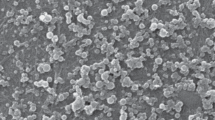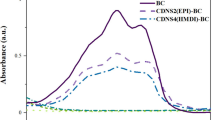Abstract
The use of the organic cosolvents tetrahydrofuran and dimethylsulfoxide was found to be unsuitable for prostate tunor cell cultures because of solvent cytotoxicity and the poor solubility and instability of lycopene. For example, the half-life of lycopene in organic/aqueous solution was found to be less than 2 h. Therefore, a micellar preparation of lycopene was developed for the solubilization and stabilization of lycopene in cell culture media. Neither the micelles themselves nor lycopene solubilized in micelles at concentrations up to 10 μg/mL. in the cell culture media produced cytotoxicity or inhibition of cell proliferation in either LNCaP human prostate cells or Hs888Lu human lung cells. Lycopene solubilized in micelles was stable for at least 96 h under standard cell culture conditions so that a constant lycopene supply could be provided to the cells. During the culture process, lycopene was taken up by LNCaP cells and reached a plateau at approximately 12 h. Micelles provide a convenient, inexpensive, and nontoxic vehicle for dissolving and stabilizing carotenes such as lycopene in tissue culture media and then delivering them to cells growing in culture.
Similar content being viewed by others
Abbreviations
- APCL:
-
atmospheric pressure chemical ionization
- BHT:
-
butylated hydroxytoluene
- HDL:
-
high density lipoproteins
- HPLC:
-
high-performance liquid chromatography
- LC-MS:
-
liquid chromatography-mass spectrometry
- LDL:
-
fow density lipoprotein
- RPMT:
-
Roswell Park Memorial Institute
- SRB:
-
sulforhodamine B
- THF:
-
tetrahydrofuran
- UV/VIS:
-
ultraviolet/visible
References
Straub, O. (1987) Key to Carotenoids, Birkhuser-Verlag, Basel, pp. 1–276.
Britton, G. (1995) Carotenoids 1: Structure and Properties of Carotenoids in Relation to Function, FASEB J, 9, 1551–1558.
Olson, J.A. (1994) Vitamin A, Retinoids, and Carotenoids, in Modern Nutrition in Health and Disease (Shils, M.E., Olson, J.A., and Shike, M., eds.), 8th ed., pp. 287–307, Lea & Febiger, Philadelphia.
Dimascio, P., Kaiser, S., and Sies, H. (1989) Lycopene as the Most Efficient Biological Carotenoid Singlet Oxygen Quencher, Arch Biochem. Biophys. 274, 532–538.
Furr, H.C., and Clark, R.M. (1997) Intestinal Absorption and Tissue Distribution of Carotenoids, J. Nutr. Biochem. 8, 364–377.
Parker, R.S. (1996) Carotenoids 4: Absorption, Metabolism, and Transport of Carotenoids, FASEB J. 10, 542–551.
Krinsky, N.I. (1994) The Biological Properties of Carotenoids, Pure Appl. Chem. 66, 1003–1010.
Giovannucci, E., Ascherio, A., Rimm, E.B., Stampfer, M.J., Colditz, G.A., and Willett, Q.C. (1995) Intake of Carotenoids and Retinol in Relation to Risk of Prostate Cancer, J. Natl. Cancer Inst. 87, 1767–1776.
Gann, P.H., Ma, J., Giovannucci, E., Willett, W., Sacks, F.M., Hennekens, C.H., and Stampfer, M.J. (1999). Lower Prostate Cancer Risk in Men with Elevated Plasma Lycopene Levels: Results of a Prospective Analysis, Cancer Res. 59, 1225–1230.
Giovannucci, E. (1999) Tomatoes, Tomato-Based Products, Lycopene, and Cancer: Review of the Epidemiological Literature, J. Natl. Cancer Inst. 91, 317–331.
Cooney, R.V., Kappock, T.J., Pung, A., and Bertram, J.S. (1993) Solubilization, Cellular Uptake and Activity of β-Carotene and Other Carotenoids as Inhibitors of Neoplastic Transformation in Cultured Cells, Methods Enzymol. 214, 55–68.
Ukai, N., Nakamura, H., Lu, Y., Etoh, H., Ina, K., Ohshima, S., Ojima, F., Sakamoto, H., and Ishiguro, Y. (1996) The Water-Soluzilization and Stabilization of Lycopene by Cyclodextrin and Addition of protein, Nippon Kagaku Kaishi 43, 247–250.
El-gorab, M. and Underwood, B.A. (1973) Solubilization of Beta-Carotene and Retinol into Aqueous Solutions of Mixed Micelles, Biochim. Biophys. Acta 306, 58–66.
Martin, K.R., Failla, M.L., and Smith, J.C., Jr. (1996) β-Carotene and Lutein Protect HepG2 Human Liver Cells Against Oxidant-Induced Damage, J. Nutr. 126, 2098–2106.
Martin, K.R., Loo, G., and Failla, M.L. (1997) Pluman Lipoproteins as a Vehicle for the Delivery of β-Carotene and α-Tocopherol to HepG2 Cells, Proc. Soc. Exp. Biol. Med. 214, 367–373.
van Breemen, R.B., Huang, C.-R., Tan, Y., Sander, L.C., and Schilling, A.B. (1996) Liquid Chromatography/Mass Spectrometry of Carotenoids Using Atmospheric Pressure Chemical ionization, J. Mass Spectrom 31, 975–981.
Stahl, W., and Sies, H. (1996) Lycopene: A Biologically Important Carotenoid for Humans? Arch. Biochem. Biophys. 336, 1–9.
Sutherland, W.H., Walker, R.J., De Jong, S.A., and Upritchard, J.E. (1999) Supplementation with Tomato Juice Increases Plasma Lycopene but Does not Alter Susceptibility to Oxidation of Low Density Lipoproteins from Renal Transplant Recipients, Clin. Nephrol. 52, 30–36.
Clinton, S.K., Emenheiser, C., Schwartz, S.J., Bostwick, D.G., Williams, A.W., Moore, B.J., and Erdman, J.W. (1996) Cistrans Lycopene Isomers, Carotenoids and Retinol in Human Prostate, Cancer Epidemiol. Biomarkers Prev. 5, 823–833.
Author information
Authors and Affiliations
About this article
Cite this article
Xu, X., Wang, Y., Constantinou, A.I. et al. Solubilization and stabilization of carotenoids using micelles: Delivery of lycopene to cells in culture. Lipids 34, 1031–1036 (1999). https://doi.org/10.1007/s11745-999-0454-9
Received:
Revised:
Accepted:
Issue Date:
DOI: https://doi.org/10.1007/s11745-999-0454-9




